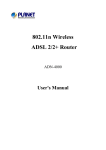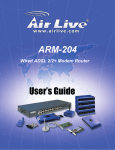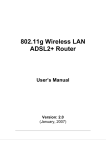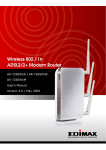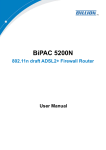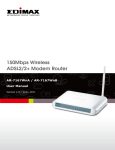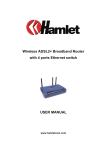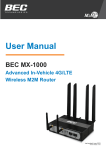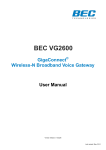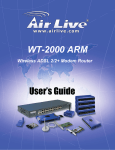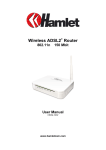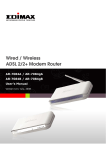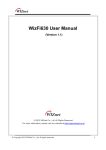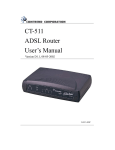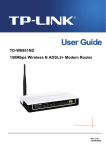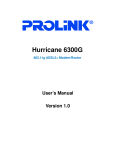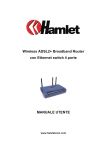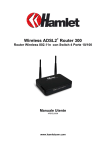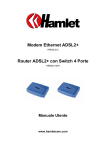Download manual - Crypto Electronics
Transcript
Airdata 300 ADSL
11n Wireless 300 Mbps ADSL 2/2+ Modem-Router
manual
Version 1.0
Airdata 300 11n Wireless ADSL Manual
Contents
1. PRODUCT INFORMATION ..............................................................................1
1.1 Product Features......................................................................................................................................2
1.2 Package Contents.....................................................................................................................................3
1.3 Front Panel ...............................................................................................................................................4
1.4 Rear Panel.................................................................................................................................................5
2. SYSTEM AND NETWORK SETUP ..................................................................6
2.1 Installing the ADSL modem-router to your Network ...........................................................................6
3. SETUP WIZARD...............................................................................................7
4. IP ADDRESS SETTING .................................................................................15
5. WEB MANAGEMENT CONFIGURATION .....................................................18
6. INTERFACE SETUP ......................................................................................26
6.1 Internet ...................................................................................................................................................26
6.2 LAN.........................................................................................................................................................31
6.3 Wireless...................................................................................................................................................34
7. ADVANCED SETUP.......................................................................................42
7.1 Firewall...................................................................................................................................................42
7.2 Routing ...................................................................................................................................................43
7.3 NAT.........................................................................................................................................................46
7.4 ADSL.......................................................................................................................................................50
Airdata 300 11n Wireless ADSL Manual
8. ACCESS MANAGEMENT ..............................................................................51
8.1 ACL.........................................................................................................................................................51
8.2 Filter .......................................................................................................................................................53
8.3 IP/MAC Filter........................................................................................................................................54
8.4 Application Filter...................................................................................................................................56
8.5 URL Filter ..............................................................................................................................................57
8.6 SNMP......................................................................................................................................................58
8.7 UPnP .......................................................................................................................................................59
8.8 DDNS ......................................................................................................................................................60
9. MAINTENANCE .............................................................................................62
9.1 Administrator.........................................................................................................................................62
9.2 Time Zone...............................................................................................................................................63
9.3 Firmware ................................................................................................................................................64
9.4 System Restart .......................................................................................................................................65
9.5 Diagnostics .............................................................................................................................................66
10. STATUS........................................................................................................67
10.1 Device Info............................................................................................................................................67
10.2 System Log ...........................................................................................................................................68
10.3 Statistics................................................................................................................................................69
11. TECHNICAL SUPPORT ...............................................................................70
Airdata 300 11n Wireless ADSL Manual
1. Product Information
Crypto’s Airdata 300 ADSL is a cost-effective ADSL2+ router, with the combination of
an ADSL2+ modem, router, Ethernet network switch and wireless access point, you can
surf the Internet through your ADSL2/2+ broadband connection without investing on
other devices.
This router can support downstream transmission rates of up to 24Mbps and upstream
transmission rates of up to 1Mbps. It supports PPPoA (RFC 2364 - PPP over ATM
Adaptation Layer 5), RFC 1483/2684 encapsulation over ATM (bridged or routed) and
PPP over Ethernet (RFC 2516) to establish a connection with ISP. The product also
supports VC-based and LLC-based multiplexing.
With built-in IEEE 802.11b/g/Draft-N wireless network capability, all computers and
wireless-enabled network devices (including PDA, cellular phones, game consoles) can
connect to this ADSL router without additional cabling. New Draft-N wireless capability
also gives you the highest speed of wireless experience ever! With a compatible wireless
card installed in your PC, you can transfer files at speeds of up to 300Mbps. The radio
coverage is also doubled, allowing you to get the benefits of wireless networking thought
your house or office.
Utilizing the web management interface, users can easily configure the various functions
of the router including DHCP server, NAT, virtual server, DMZ, access control,
IP/MAC/Application/URL filter, Firewall, PPTP/IPSec/L2TP pass-through, DDNS,
UPnP, Wireless and etc.
The Crypto Airdata 300 ADSL modem- router is a high performance and high-speed
device that provides a full rate of ADSL2+ standard with the superb reliability and a
complete solution for home and office application.
-1-
Airdata 300 11n Wireless ADSL Manual
1.1 Product Features
ADSL2/2+ Compliance
• Support downstream rates of up to 24Mbps and upstream rates of up to 1Mbps.
• Compliant to ITU-T G.992.1 (G.dmt), G.992.2 (G.lite), G.992.3 (ADSL2),
G.992.4 (splitterless ADSL2), G.992.5 (ADSL2+) for Annex A, B. (Annex A and
B are supported in different H/W platform)
•
Supports Multi-Mode standard (ANSI T1.413, Issue 2; G.dmt (G.992.1); G.994.1
and G.996.1 (for ISDN only); G.991.1;G.lite (G992.2)).
•
Multiple Protocols over AAL5 (RFC 1483/2684).
•
PPP over AAL5 (RFC 2364).
•
PPP over Ethernet (RFC 2516).
Support 802.11n Wireless Access Point
• Complies with IEEE 802.11n draft 2.0, IEEE 802.11g and IEEE 802.11b
•
standards.
Further coverage, less dead spaces and higher throughput with MIMO technology.
•
High data rate – up to 300Mbps network speed.
•
Supports 64-bit/128-bit WEP, WPA-PSK and WPA2-PSK wireless security
•
functions.
Supports WPS (WiFi Protected Setup) to easy connect wireless network without
configuring the security.
•
Support Auto Channel Selection.
•
Supports MAC address filtering.
Router
• NAT (Network Address Translation) IP Sharing
•
•
Virtual Server
DMZ
•
VPN Pass Through (IPSec/PPTP/L2TP)
•
SPI Anti-DOS Firewall
•
DHCP Server and Client
-2-
Airdata 300 11n Wireless ADSL Manual
Access Management
• ACL (Access Control)
• IP/MAC/Application/URL Filter
•
UPnP (Universal Plug and Play)
•
SNMP
•
Dynamic DNS
1.2 Package Contents
The product package should have the following items:
• One ADSL2/2+ Router (Annex A or B)
•
Three Detachable Dipole Antennas
•
One Power Adapter (12VDC, 1A)
•
•
One RJ-45 Ethernet Cable (100 cm)
One RJ-11 Telephone Line (180 cm)
•
One Quick Installation Guide
•
One CD with full User Manual
-3-
Airdata 300 11n Wireless ADSL Manual
1.3 Front Panel
On the router’s front panel there are LED lights that inform you the router’s current
status. Below is an explanation of each LED and its description.
LED
Light Status
Description
PWR (Green)
On
The router is ready
WLAN (Yellow)
Off
Wireless LAN is disabled
Blinking
Wireless traffic is transmitting or receiving
Off
WPS function is disabled
Blinking
WPS function is enabled
On
Connected to an ADSL DSLAN successfully
Blinking
No connection
On
Off
The LAN cable is connected to the router
No network connection.
Blinking
Network traffic transferring or receiving
through the LAN port
WPS (Yellow)
ADSL (Green)
LAN LNK/ACT (Port 1-4)
-4-
Airdata 300 11n Wireless ADSL Manual
1.4 Rear Panel
1) Antenna Connector
The antenna connector of the router is reverse SMA connector. It allows you to
connecting an external antenna with reverse SMA connector to the router easily.
2) Reset
The Reset button can be used to reset the router or restore to factory defaults.
z
If problems occur with your router, press the router’s reset button with a pencil
tip (for less than 5 seconds) and the router will re-boot itself, keeping your
original configurations.
z
If problems persist or you experience extreme problems or you forgot your
password, press the reset button for longer than 5 seconds and the router will
reset itself to the factory default settings (warning: your original configurations
will be replaced with the factory default settings)
-5-
Airdata 300 11n Wireless ADSL Manual
3) Power Jack
Please plug the power adapter attached with the ADSL Router to the power jack. The
power adapter is 12VDC, 1A.
4) WPS
Wi-Fi Protected Setup (WPS) is the simplest way to build connection between
wireless network clients and this ADSL router. Press this button on the router and
enable WPS function of the wireless clients, the router and clients will automatically
configure the security key and connect directly. Please note that the router will wait
for WPS requests from wireless clients in 2 minutes after the WPS button is pressed.
5) Local Area Network (LAN)
The router’s 4 LAN ports are where you connect your LAN’s PCs, printer servers,
hubs and switches etc.
6) ADSL
Connect the supplied RJ-11 telephone line to this port and your ADSL/telephone
network.
2. System and Network Setup
2.1 Installing the ADSL modem-router to your Network
Step 1. Connect the ADSL Line
Connect the router to your ADSL cable through the supplied RJ-11 telephone line.
Step 2. Connect the router to your LAN network
Connect the router to your PC , hub or switch by attaching the Ethernet cable to the LAN
port of the router.
Step 3. Connect the Power Adapter to the Router
Connect the power adapter to the power jack on the rear panel of router.
-6-
Airdata 300 11n Wireless ADSL Manual
Step4: Check the ADSL LED on the Router
The ADSL LED will be ON if the router is connected to the ADSL line and receives the
ADSL signals successfully. If the LED is blinking, please contact with your ISP (Internet
Service Provider) to check the problem.
Note: You must use the power adapter shipped along with the router, do NOT use any
other power adapter from other sources.
3. Setup Wizard
This router provides a Setup Wizard tool for user configuration of the ADSL settings.
This wizard collects some ISP’s ADSL settings so that user can easy to configure the
router’s ADSL settings by only selecting the ISP vendor from the wizard.
If you cannot find your ISP from the list in the wizard, please manually set the ISP
information through the wizard.
Getting Started
Before you start, please check the following items:
1. Please make sure that you have connected the ADSL cable to the router correctly.
When the ADSL cable is working normally, the ADSL LED will be on.
2. Uninstall all of dial up programs if you have installed previously for the USB modem
or other dial up devices.
3. It is recommended to configure the router through the Ethernet cable before you have
set the wireless functions correctly.
The following procedures are operated in Windows XP. (Same procedures apply for
Windows Vista also.)
Insert the CD shipped along with the ADSL router into your CD-ROM drive. The
Autorun.exe program should be executed automatically. If not, run Autorun.exe manually
from “Autorun” folder in the CD. The following screen will be displayed. Click “Setup
Wizard”.
-7-
Airdata 300 11n Wireless ADSL Manual
This wizard will be executed and try to search for the ADSL Router.
If the router cannot be found, please enter the IP Address and the Password of the router
to search again. Click “Next” to continue.
-8-
Airdata 300 11n Wireless ADSL Manual
If you cannot find the ISP, please click “Other” to reselect the country or manual
configure the ISP information.
-9-
Airdata 300 11n Wireless ADSL Manual
Before configuring the ISP manually, please check with your ISP (Internet Service
Provider) what kind of service is provided such as PPPoE, PPPoA or RFC1483/2684.
Gather the information as illustrated in the following table and keep it for reference.
PPPoE
VPI/VCI, VC-based/LLC-based multiplexing, Username,
Password (and Service Name).
PPPoA
VPI/VCI, VC-based/LLC-based multiplexing, Username,
Password.
RFC1483 Bridged
VPI/VCI, VC-based/LLC-based multiplexing to use Bridged
Mode.
RFC1483 Routed
VPI/VCI, VC-based/LLC-based multiplexing, IP Address,
Subnet Mask, Gateway Address, and Domain Name System
(DNS) IP Address (It is a fixed IP Address).
Please select “Other”.
Please check with your ISP the connection type of the ADSL line. Select the Connection
Type and continue.
- 10 -
Airdata 300 11n Wireless ADSL Manual
Input the VPI, VCI and Encapsulation data supplied by your ISP. Note: The values
represented here are used for demonstration purposes only.
- 11 -
Airdata 300 11n Wireless ADSL Manual
Enter the Username and Password which your ISP has provided to you if it is needed.
Click “Next”.
Save the settings and reboot the router.
- 12 -
Airdata 300 11n Wireless ADSL Manual
After saving and rebooting the router, the ISP settings are all finished. This wizard will
then help to set your computer to obtain IP Address from the router automatically.
The wizard will try to connect to the ISP you have selected. If the connection is failed,
please run the wizard to select the ISP again.
- 13 -
Airdata 300 11n Wireless ADSL Manual
Please make sure that you have disabled any antivirus program that you might use in
order for the wizard to complete the configuration. After the successful completion of the
wizard you will get the following page.
- 14 -
Airdata 300 11n Wireless ADSL Manual
When you connect with the ISP, you can browse the Internet and use all the capabilities
of the Airdata 300 ADSL device.
4. IP Address Setting
Using the router to get into the Internet, the PCs in the network must have Ethernet
adapter installed and be connected to the router either directly or through a hub or switch.
The TCP/IP protocol of each PC has to been installed and the IP Address of each PC has
to be set in the same subnet as the router.
The router’s default IP Address is 192.168.2.1 and the subnet mask is 255.255.255.0. PCs
can be configured to obtain IP Address automatically through the DHCP Server of the
router or a fixed IP Address in order to be in the same subnet as the router. By default, the
DHCP Server of the router is enabled and will dispatch IP Address to PC from
192.168.2.100 to 192.168.2.200. It is strongly recommended to set obtaining IP address
automatically.
This section shows you how to configure your PC’s so that it can obtain an IP address
automatically for either Windows 95/98/Me, 2000 or NT operating systems. The
following is a step-by-step illustration on how to configure your PC to obtain an IP
address automatically for Windows Vista, Windows XP, Windows 2000, Windows
95/98/Me and Windows NT.
Windows Vista
1. Click the Start button and select Settings and then select Control Panel. Double click
Network and Sharing Center, the Network and Sharing Center window will appear.
2. Click Manage network connections and right click on the Local Area Connection
icon and select Properties. The Local Area Connection window will appear.
3. Check your list of Network Components. You should see Internet Protocol Version 4
(TCP/IPv4) on your list. Select it and click the Properties button.
- 15 -
Airdata 300 11n Wireless ADSL Manual
4. In the Internet Protocol Version 4 (TCP/IPv4) Properties window, select Obtain an
IP address automatically and Obtain DNS server address automatically as shown on
the following screen.
5. Click OK to confirm the setting. Your PC will now obtain an IP address
automatically from your router’s DHCP server.
Note: Please make sure that the router’s DHCP server is the only DHCP server
available on your LAN.
- 16 -
Airdata 300 11n Wireless ADSL Manual
Windows XP
1. Click the Start button and select Control Panel and then double click Network
Connections. The Network Connections window will appear.
2. Right click on the Local Area Connection icon and select Properties. The Local Area
Connection window will appear.
3. Check your list of Network Components. You should see Internet Protocol [TCP/IP]
on your list. Select it and click the Properties button.
4. In the Internet Protocol (TCP/IP) Properties window, select Obtain an IP address
automatically and Obtain DNS server address automatically as shown on the
following screen.
- 17 -
Airdata 300 11n Wireless ADSL Manual
5. Click OK to confirm the setting. Your PC will now obtain an IP address
automatically from your router’s DHCP server.
Note: Please make sure that the router’s DHCP server is the only DHCP server
available on your LAN.
5. Web Management Configuration
Once you have configured your PCs to obtain an IP address automatically, the router’s
DHCP server will automatically give your LAN clients an IP address. By default the
router’s DHCP server is enabled so that you can obtain an IP address automatically.
Once your PC has obtained an IP address from your router, enter the default IP address
192.168.2.1 (router’s IP address) into your PC’s web browser and press <enter>
The login screen below will appear. Enter the “User Name” and “Password” and then
click <OK> to login. By default the user name is “admin” and the password is “admin”.
For security reasons it is recommended that you change the password as soon as possible.
- 18 -
Airdata 300 11n Wireless ADSL Manual
The HOME page screen below will appear. The Home Page is divided into seven
sections: Quick Start, Interface Setup, Advanced Setup, Access Management,
Maintenance, Status and Help.
- 19 -
Airdata 300 11n Wireless ADSL Manual
Quick Start
Follow the setup process in the Quick Start; you can quickly set the router as an Internet
Access device.
Interface Setup
It allows you to configure the Internet, LAN and Wireless access.
Advanced Setup
This section contains configurations for the router’s advanced functions such as Firewall,
Virtual Server, DMZ, ADSL Mode, ADSL Type, etc.
Access Management
It allows you to configure ACL, IP/MAC/Application/URL Filter, SNMP, UPnP and
DDNS functions.
Maintenance
If you want to change the administrator’s password, restart the router, update the
firmware, backup the settings, diagnose the connection or change the Tome Zone of the
router, please select this menu.
Status
The router’s setup information, system log and some statistics can be viewed here.
Help
If you want to know about the settings of the router quickly, please refer to the
description in the Help menu.
- 20 -
Airdata 300 11n Wireless ADSL Manual
Quick Start
The Quick Start section is designed to get you using the router as quickly as possible.
Before configuring the router, please check with your ISP (Internet Service Provider)
what kind of service is provided such as PPPoE, PPPoA or RFC1483/2684. Gather the
information as illustrated in the following table and keep it for later reference.
PPPoE
VPI/VCI,
VC-based/LLC-based
multiplexing,
Username,
multiplexing,
Username,
Password (and Service Name).
PPPoA
VPI/VCI,
Password.
VC-based/LLC-based
RFC1483 Bridged
VPI/VCI, VC-based/LLC-based multiplexing to use Bridged
Mode.
RFC1483 Routed
VPI/VCI, VC-based/LLC-based multiplexing, IP Address,
Subnet Mask, Gateway Address, and Domain Name System
(DNS) IP Address (It is a fixed IP Address).
In the Quick Start, click “Run Wizard” to start the configuration.
- 21 -
Airdata 300 11n Wireless ADSL Manual
Please follow the steps in the setup wizard to complete the configuration of the Internet
connection.
- 22 -
Airdata 300 11n Wireless ADSL Manual
Step 1: Set your new password
Please enter the new password and confirm the password again.
Step 2: Choose your tome zone
Please select the tome zone where you are located.
- 23 -
Airdata 300 11n Wireless ADSL Manual
Step 3: Set your Internet connection
Please check with your ISP the connection type of the ADSL line.
- 24 -
Airdata 300 11n Wireless ADSL Manual
Step 4: Input the data supplied by your ISP
Step 5: Re-start your ADSL router
Click “Next” to save the settings and restart the router.
- 25 -
Airdata 300 11n Wireless ADSL Manual
6. Interface Setup
6.1 Internet
z
ATM VC
Parameter
Virtual Circuit
Description
VPI (Virtual Path Identifier) and VCI (Virtual Channel
Identifier define a virtual circuit.
VPI
VPI is a virtual path that determines the way an ATM cell
should be routed. The VPI is an 8-bit (in UNI) or 12-bit (in
NNI) number that is included in the header of an ATM
cell. The valid range for the VPI is 0 to 255. Enter the VPI
- 26 -
Airdata 300 11n Wireless ADSL Manual
assigned by the ISP.
Parameter
VCI
Description
VCI is the label given to an ATM VC to identify it and
determine its destination. The VCI is a 16-bit number that is
included in the header of an ATM cell. The valid range for the
VCI is 32 to 65535. Enter the VCI assigned by the ISP.
ATM QoS
CBR (Constant Bit Rate) – This class is used for emulating
circuit switching. The cell rate is constant with time. Select
CBR to specify fixed (always on) bandwidth for voice or data
traffic.
UBR (Unspecified Bit Rate) – Select UBR for applications that
are non-time sensitive, such as e-mail.
rtVBR (real time Variable Bit Rate) – This class is similar to
nrtVBR but is designed for applications that are sensitive to
cell-delay variation. Examples for real-time VBR are voice
with speech activity detection (SAD) and interactive
compressed video.
nrtVBR (non-real time Variable Bit Rate) – This class allows
users to send traffic at a rate that varies with time depending on
the availability of user information. Statistical multiplexing is
provided to make optimum use of network resources.
Multimedia e-mail is an example of nrtVBR.
PCR
Divide the DSL line rate (bps) by 424 (the size of an ATM
cell) to find the PCR (Peak Cell Rate). This is the maximum
rate at which the sender can send cells.
SCR
SCR (Sustain Cell Rate) is the average rate, as measured over a
long interval, in the order of the connection lifetime.
Parameter
Description
- 27 -
Airdata 300 11n Wireless ADSL Manual
MBS
MBS (Maximum Burst Size) refers to the maximum number of
cells that can be sent at the peak rate. Type the MBS, which is
less than 65535.
Encapsulation
The router can be connected to your service provider in any of the following ways.
z
Parameter
Dynamic IP Address
Description
Obtain an IP address automatically from your service provider.
Static IP Address
Uses a static IP address. Your service provider gives a static IP
address to access Internet services.
PPPoE/ PPPoA
PPPoE (PPP over Ethernet) and PPPoA (PPP over ATM) are
common connection methods used for xDSL.
Bridge Mode
Bridge Mode is a common connection method used for xDSL
modem.
Dynamic IP Address/Static IP Address/PPPoE/PPPoA/Bridge Mode
After you have selected the ISP Type, this web page will be varied depending on the ISP
Type you select. You have to continue setting some parameters. Please refer to the
z
following table for the explanation of each parameter.
Parameter
Service name
Description
Enter the name of your ISP.
User Name
Enter the username exactly as your ISP assigned.
Password
Enter the password that your ISP has assigned to you.
Encapsulation
Please check with your ISP the method of multiplexing. In
Bridge Mode, please select “1483 Bridge IP LLC” or “1483
Bridge IP VC-Mux”. In PPPoE/PPPoA mode, please select
“PPPoE LLC”, “PPPoE VC-Mux”, “PPPoA LLC”, or “PPPoA
- 28 -
Airdata 300 11n Wireless ADSL Manual
VC-Mux”.
Bridge Interface
This router has built-in ADSL modem and is able to connect to
ISP directly. Alternatively, if you want to use the dial up
software to manually connect to the ISP, you have to activate
the ”Bridge Interface”.
Parameter
Connection
Description
Always On – The connection will be kept always on. If the
connection is
automatically.
interrupted,
the
router
will
re-connect
Connect On-Demand – Only connect when you want to surf
the Internet. “Close if idle for xx minutes” is set to stop the
connection when the network traffic is not sending or receiving
after an idle time.
Connect Manually – After you have selected this option, please
go to Status page. You will see the “Connect” button, click it
and the router will connect to the ISP. If you want to stop the
connection, please click “Disconnect” button.
TCP MSS Option
The “TCP MSS Option” enables the configuration of the
maximum segment size (MSS) for transient packets that
traverse a router, specifically TCP segments in the SYN bit set,
when PPPoE is being used in the network. Please specify the
MSS range from 100 to 1452 bytes or 0 byte as the default
value.
Get IP Address
Choose Static or Dynamic IP Address. If Static IP is selected,
please set the IP Address, Subnet Mask and Gateway obtained
from your ISP.
Static IP Address
Enter the IP Address assigned by your ISP.
- 29 -
Airdata 300 11n Wireless ADSL Manual
IP Subnet Mask
Enter the Subnet Mask assigned by your ISP.
Gateway
Enter the Gateway assigned by your ISP.
Parameter
NAT
Description
NAT (Network Address Translation), is an Internet standard
that enables a local-area network (LAN) to use one set of IP
addresses for internal traffic and a second set of addresses for
external traffic. When NAT is enabled, the router will help to
make all necessary IP address translations for the PC
connected to the router to access the Internet.
Default Route
When “Default Router” is enabled, all the packets for
destinations not known by the router's routing table are sent to
the default route. By default, it is enabled.
TCP MTU Option
MTU (Maximum Transmission Unit) determines the maximum
size of each packet in any transmission within the network.
Please specify the MTU range from 100 to 1500 bytes or 0
byte as the default value.
Dynamic Route
Dynamic routing allows routing tables in routers to change as
the possible routes change. This router supports RIP1, RIP2-B
and RIP2-M protocols for dynamic routing. After the RIP
protocol is selected, please choose the RIP direction from
“None”, “Both”, “IN Only” or “OUT Only”.
Multicast
Specify the method of transmitting data simultaneously to
many receivers. Please select “IGMP v1” or “IGMP v2” as the
multicast protocol or select “Disabled” to disable the function.
MAC Spoofing
Once your ISP service requires identifying the MAC address of
the devices. You can enable MAC Spoofing function and enter
the valid MAC address, it allows you to change the MAC
address of the router in order to access to the Internet service.
- 30 -
Airdata 300 11n Wireless ADSL Manual
6.2 LAN
z
Router Local IP
Parameter
IP Address
Description
Enter the IP Address of the ADSL router for the local user to
access the router’s web page. By default, the IP Address is
192.168.2.1.
IP Subnet Mask
Enter the Subnet Mask of the ADSL router. By default, the
Subnet Mask is 255.255.255.0.
Dynamic Route
Dynamic routing allows routing tables in routers to change as
the possible routes change. This router supports RIP1, RIP2-B
and RIP2-M protocols for dynamic routing. After the RIP
- 31 -
Airdata 300 11n Wireless ADSL Manual
protocol is selected, please choose the RIP direction from
“None”, “Both”, “IN Only” or “OUT Only”.
Parameter
Multicast
Description
Specify the method of transmitting data simultaneously to
many receivers. Please select “IGMP v1” or “IGMP v2” as the
multicast protocol or select “Disabled” to disable the function.
IGMP Snoop
When “IGMP Snoop” (Internet Group Management Protocol
Snoop) is enabled, the router can make intelligent multicast
forwarding decisions by examining the contents of each
frame’s IP header. Without the function, the router will
broadcast the multicast packets to each port and may create
excessive traffic on the network and degrade the performance
of the network.
z
DHCP
Parameter
DHCP
Description
You can enable or disable the DHCP server. By enabling the
DHCP server the router will automatically give your LAN
clients an IP address. If the DHCP is not enabled then you’ll
have to manually set your LAN client’s IP addresses.
Starting IP Address
If the DHCP Server is enabled, please set the “Starting IP
Address” which will be the first IP Address assigned to the
LAN client. By default, the “Starting IP Address” is
192.168.2.100.
IP Pool Count
You can select a particular IP address range for your DHCP
server to issue IP addresses to your LAN Clients.
By default, the “IP Pool Count” is 100. The IP range is starting
from IP 192.168.2.100 to 192.168.2.199.
- 32 -
Airdata 300 11n Wireless ADSL Manual
Parameter
Lease Time
Description
In the Lease Time setting you can specify the time period that
the DHCP Server lends an IP address to your LAN clients. The
DHCP will change your LAN client’s IP address when this
time threshold period is terminated.
DNS Relay
A Domain Name System (DNS) server is like an index of IP
addresses and Web addresses. If you type a Web address into
your browser, such as “www.router.com”, a DNS server will
find that name in its index and the matching IP address. Please
select “Use Auto Discovered DNS Server Only” to auto set the
DNS Server. If there is a DNS server that you would rather to
use, please select “Use Discovered DNS Server Only” and you
need to specify the IP address of that DNS server.
Primary DNS Server
Enter the ISP’s DNS Server IP Address; or you can specify
your own preferred DNS Server IP Address.
Secondary DNS Server
This is optional. You can enter another DNS Server’s IP
Address as a backup. The secondary DNS will be used should
the Primary DNS fail.
- 33 -
Airdata 300 11n Wireless ADSL Manual
6.3 Wireless
z
Access Point Settings
Parameter
Access Point
Description
Activated or deactivated the wireless function of the router.
When it is activated, the router will be an access point for other
wireless clients to connect wirelessly.
Parameter
Channel
Description
It is the radio channel used by the wireless LAN. All devices in
the same wireless LAN should use the same channel. Please
select the country you are located and designate a channel that
the router will use. For product available in the USA/Canada
market, only channel 1~11 can be operated. For product
- 34 -
Airdata 300 11n Wireless ADSL Manual
available in Europe market, only channel 1~13 can be
operated. Selection of other channels is not permitted. If you
want to let the router automatically to find an available channel
with the highest signal strength, please select “Auto”. The
auto-selective channel will be shown in the “Current Channel”
field.
Beacon Interval
The interval of time that this wireless router broadcast a
beacon. Beacon is used to synchronize the wireless network.
The range for the beacon period is between 20 and 1000 with a
typical value of 100 (milliseconds).
RTS/CTS Threshold
When the packet size is smaller than the RTS threshold, the
wireless router will not use the RTS/CTS mechanism to send
this packet. The range is from 1500 to 2347.
Fragmentation Threshold Fragment Threshold specifies the maximum size of packet
during the fragmentation of data to be transmitted. If you set
this value too low, it will result in bad performance. Enter a
value from 256 to 2346.
DTIM
Determines the interval the Access Point will send its
broadcast traffic. The range is from 1 to 255 and the default
value is 3 beacons.
Parameter
Wireless Mode
Description
802.11b – It only allows 802.11b wireless network client to
connect this router (maximum transfer rate 11Mbps).
802.11g – It only allows 802.11g wireless network client to
connect this router (maximum transfer rate 54Mbps).
802.11b+g – It only allows 802.11b and 802.11g wireless
network client to connect this router (maximum transfer rate
11Mbps for 802.11b clients, and maximum 54Mbps for
- 35 -
Airdata 300 11n Wireless ADSL Manual
802.11g clients).
802.11n – It only allows 802.11n wireless network client to
connect this router (maximum transfer rate 300Mbps).
802.11g+n – It allows 802.11g, and 802.11n wireless network
client to connect this router (maximum transfer rate 54Mbps
for 802.11g clients, and maximum 300Mbps for 802.11n
clients).
802.11b+g+n – It allows 802.11b, 802.11g, and 802.11n
wireless network client to connect this router (maximum
transfer rate 11Mbps for 802.11b clients, maximum 54Mbps
for 802.11g clients, and maximum 300Mbps for 802.11n
clients).
NOTE: For 802.11b and 802.11g mode, the signals can be
transmitted only by antenna 1 (The antenna in the right side of
the rear panel).
For 802.11n mode: The router is operating in a 2T3R Spatial
Multiplexing MIMO configuration. 2 antennas are for signal
transmitting and 3 antennas are for signal receiving.
z
11n Settings
Parameter
Channel Bandwidth
Description
Set channel width of wireless radio. Do not modify default
value if you don’t know what it is, default setting is ‘20/40
MHz’.
Extension Channel
Select the extension channel to above or below the control
channel while 40MHz channel bandwidth is selected. Do not
modify the default value if you don’t know what it is.
- 36 -
Airdata 300 11n Wireless ADSL Manual
Guard Interval
It is one of several draft-n features designed to improve
efficiency. Select 400nsec to provide a shorter delay between
transmission frames in 11n network. The throughput in 400nec
guard interval is better than 800nsec guard interval.
MCS
Select MCS 0-15 to configure the data rate of 11n network.
When MCS 15 is selected, the data rate is up to 300Mbps. It is
recommended to set “Auto” and the router will negotiate with
wireless clients to operate in a proper data rate.
Multiple SSIDs Settings
Parameter
SSID Index
Description
This router can support multiple SSIDs. By default, this
function is disabled. You can only set a set of SSID.
Broadcast SSID
Select “Yes” to make the SSID to be visible so wireless clients
can scan the router within the network. Select “No” if you
want to hide the SSID of the router. Wireless clients have to set
the same SSID of the router in order to access the network.
WMM
The short of Wi-Fi Multi Media, it will enhance the data
transfer performance of multimedia contents when they’re
being transferred over wireless network.
Use WPS
Select “Yes” to enable WPS function, Select “No” to disable
WPS.
- 37 -
Airdata 300 11n Wireless ADSL Manual
WPS Settings
Wi-Fi Protected Setup (WPS) is the simplest way to build connection between wireless
network clients and this router. You don’t have to select encryption mode and input a
long encryption pass phrase every time when you need to setup a wireless client, you
only have to press a button on wireless client and this wireless router, and the WPS will
do the setup for you.
This router supports two types of WPS: Push-Button Configuration (PBC), and PIN code.
If you want to use PBC, you have to switch this wireless router to WPS mode and push a
specific button on the wireless client to start WPS mode. You can push Reset/WPS button
of this router, or select “PBC” and click “Start WPS” button in the WPS setup page to do
this. If you want to use PIN code, you have to know the PIN code of wireless client and
switch it to WPS mode, then set the PIN code of the wireless client you wish to connect
to this router in the WPS setup page and click “Start WPS” button to start WPS mode.
Parameter
WPS state
Description
If the wireless security (encryption) function of this wireless
router is enabled, you’ll see ”Configured” message here. If
wireless security function has not been set, you’ll see
‘”Unconfigured”.
WPS mode
When PIN code is selected, you have to enter the 8-digit PIN
code of the wireless client you wish to connect to this router.
If PBC mode is selected, just click “Start WPS” button to start
WPS mode.
AP self PIN Code
The PIN code of the router. You can enter the PIN code of the
router to the wireless client so the wireless client can start WPS
mode to connect to the router. The security settings of the
router will be set to the same as the wireless client.
Parameter
Enrollee PIN Code
Description
Enter the PIN code of the wireless client here. If you have
- 38 -
Airdata 300 11n Wireless ADSL Manual
entered the PIN code of the wireless client and switch to the
WPS mode, the security settings of the wireless client will be
set to the same as the router.
WPS progress
Display the progress during WPS communication.
Reset to OOB
Click this button and all the wireless settings of the router will
be reset to factory defaults.
SSID
The SSID (up to 32 printable ASCII characters) is the unique
name identified in a WLAN. The ID prevents the unintentional
merging of two co-located WLANs. The default SSID of the
router is “default”.
Authentication Type
It’s very important to set wireless security settings properly. If
you don’t, hackers and malicious users can reach your network
and valuable data without your consent and this will cause
serious security problem.
This router supports WEP, WPA-PSK and WPA2-PSK
authentication type. If the router has enabled the
authentication, all the wireless clients settings have to be
consistent with the router for building the connection.
- 39 -
Airdata 300 11n Wireless ADSL Manual
z
WEP/WPA-PSK/WPA2-PSK and WPA-PSK/WPA2-PSK
Parameter
WEP-64Bits
Description
WEP supports 64-bit and 128-bit key lengths to encrypt the
wireless data. The longer key length will provide higher
security. When “WEP-64Bits” is selected, you have to enter
exactly 5 ASCII characters (“a-z” and “0-9”) or 10
hexadecimal digits ("0-9", "a-f") for each Key (1-4).
WEP-128Bits
When “WEP-128Bits” is selected, you have to enter exactly 13
ASCII characters (“a-z” and “0-9”) or 26 hexadecimal digits
("0-9", "a-f") for each Key (1-4).
WPA-PSK
WPA-PSK is suitable for home and small business. It uses
TKIP or AES for data encryption. When “WPA-PSK” is
selected, please select the encryption method and enter 8-63
ASCII characters or 64 hexadecimal characters as the “PreShared Key”.
WPA2-PSK
WPA2-PSK is also for home and small business. It uses TKIP
or AES for data encryption. WPA2-PSK offers the highest
level of security available. When “WPA2-PSK” is selected,
please select the encryption method and enter 8-63 ASCII
characters or 64 hexadecimal characters as the “Pre-Shared
Key”.
WPA-PSK/ WPA2-PSK When “WPA-PSK/WPA2-PSK” is selected, please select the
encryption method (TKIP or AES) and enter 8-63 ASCII
characters or 64 hexadecimal characters as the “Pre-Shared
Key”.
- 40 -
Airdata 300 11n Wireless ADSL Manual
z
Wireless MAC Address Filter
Parameter
Active
Description
This router can prevent the wireless clients from accessing the
wireless network by checking the MAC Address of the clients.
If you enable this function, please set the MAC Address of the
wireless clients that you want to filter.
Action
Allow Association – Only allow the wireless clients with the
MAC Address you have specified can access to the router.
Deny Association – The wireless clients with the MAC
Address you have specified will be denied accessing to the
router.
Mac Address #1-8
Please enter the MAC Address of the wireless clients for the
filtering control.
- 41 -
Airdata 300 11n Wireless ADSL Manual
7. Advanced Setup
7.1 Firewall
Parameter
Firewall
Description
When you enable the firewall function, it will protect you from
following attacks of WAN side:
z
SYN flooding attack
z
Ping of Death
z
Teardrop
Land attack
z
SPI
If you enable SPI, all traffics initiated from WAN site will be
blocked including DMZ, Virtual Server, etc.
- 42 -
Airdata 300 11n Wireless ADSL Manual
7.2 Routing
Routing Table List
You can see the current routing table of the router here. If you want to add another
z
routing rule, please click “ADD ROUTE”.
Parameter
Dest IP
Description
Show the IP Address of the destination LAN.
Mask
Show the Subnet Mask of the destination LAN. If it shows “8”
that means the Subnet Mask is “255.0.0.0”; “16” means the
Subnet Mask is “255.255.0.0”; “24” means the Subnet Mask is
“255.255.255.0”.
- 43 -
Airdata 300 11n Wireless ADSL Manual
Parameter
Gateway IP
Description
The next stop gateway of the path toward the destination LAN.
This is the IP of the neighbor router that this router should
communicate with on the path to the destination LAN.
Metric
The number of hops (routers) to pass through to reach the
destination LAN. It must be between 1 and 15.
Device
Show the interface that go to the next hop (router), such as
LAN port.
Use
The counter for access time.
Edit
Edit the route, this icon is not shown for system default route.
Drop
Drop the route, this icon is not shown for system default route.
Add Route
If you have another router with a LAN-to-LAN connection, you may need to create a
z
static routing on the router that is the gateway to Internet.
- 44 -
Airdata 300 11n Wireless ADSL Manual
Parameter
Destination IP Address
Description
Enter the IP Address of the destination LAN.
IP Subnet Mask
Enter the Subnet Mask address of the destination LAN.
Gateway IP Address
This is the gateway IP Address where packets are sent. Enter
the gateway IP Address and select the channel (PVC) you want
to configure.
Metric
The number of hops (routers) to pass through to reach the
destination LAN. It must be between 1 and 15.
Parameter
Announced in RIP
Description
Select “Yes”, this routing path will be propagated to other
hosts through RIP broadcasts. Select “No”, this routing path
will be kept private and it is not included in RIP broadcasts.
- 45 -
Airdata 300 11n Wireless ADSL Manual
7.3 NAT
Network Address Translation (NAT) allows multiple users at your local site to access the
Internet through a single Public IP Address or multiple Public IP Addresses. NAT
provides Firewall protection from hacker attacks and has the flexibility to allow you to
map Private IP Addresses to Public IP Addresses for key services such as Websites and
FTP.
Parameter
Virtual Circuit
Description
Please select the channel (PVC) you want to configure.
NAT Status
The activated or deactivated status for the NAT function will
be shown here.
Number of IPs
Select “Single” if you only have a public IP Address. Select
“Multiple” if you have multiple IP Addresses.
- 46 -
Airdata 300 11n Wireless ADSL Manual
DMZ
The DMZ Host is a local computer exposed to the Internet. When setting a particular
internal IP Address as the DMZ Host, all incoming packets will be checked by the
firewall and NAT algorithms then passed to the DMZ Host.
For example, if you have a local client PC that cannot run an Internet application (e.g.
Games) properly from behind the NAT firewall, then you can open the client up to
unrestricted two-way Internet access by defining a DMZ Host.
- 47 -
Airdata 300 11n Wireless ADSL Manual
Parameter
DMZ setting for
Description
Shows the DMZ setting for single or multiple IP Addresses.
DMZ
Enable or disable the DMZ function.
DMZ Host IP Address
Enter a static IP Address to the DMZ Host. This IP Address
will be exposed to the Internet.
Virtual Server
Use the Virtual Server function when you want different servers/clients in your LAN to
handle different service/Internet application type (e.g. Email, FTP, Web server etc.) from
the Internet. Computers use numbers called port numbers to recognize a particular
service/Internet application type. The Virtual Server allows you to re-direct a particular
service port number (from the Internet/WAN) to a particular LAN private IP Address and
its service port number.
- 48 -
Airdata 300 11n Wireless ADSL Manual
Parameter
Virtual Server for
Description
Shows the Virtual Server setting for single or multiple IP
Addresses.
Rule Index
Choose the rule number.
Application
Select the application of the virtual server, for example: FTP or
HTTP Server. When the application is selected, the port
number for the application will be assigned automatically.
Parameter
Start Port Number
Description
Enter the start port number.
End Port Number
Enter the end port number.
Local IP Address
It is recommended to enter a static IP Address for the server
here. If the server’s IP Address is obtained from DHCP Server,
the IP Address may be changed dynamically and will cause
problem on this feature. Please assign a static IP Address to the
server and make sure that the IP Address is not in the range of
IP Addresses that the DHCP Server will assign.
- 49 -
Airdata 300 11n Wireless ADSL Manual
7.4 ADSL
Parameter
ADSL Mode
Description
The default setting is “Auto Sync-Up”. This mode will
automatically detect the ADSL mode including ADSL2+,
ADSL2, G.DMT, T1.413 and G.lite. If you are not sure how to
select the ADSL mode, please contact your ISP.
ADSL Type
Check with your ISP about the ADSL type of the DSLAM
device they use.
- 50 -
Airdata 300 11n Wireless ADSL Manual
8. Access Management
8.1 ACL
If you want to restrict users from accessing certain Internet applications/services such as
Internet websites, email, FTP etc., then this is the place to set that configuration. Access
Control allows users to define the traffic type permitted in your LAN or WAN. You can
control which computer can have access to these services by entering the IP Address of
the computer.
Parameter
ACL
Description
Activate or deactivate the Access Control function. When you
have activated the function, please do make sure that you have
designated the available applications/services or you will be
denied access to all services.
- 51 -
Airdata 300 11n Wireless ADSL Manual
ACL Rule Index
This is the item number to record the setting rule.
Parameter
Secure IP Address
Description
The default 0.0.0.0~0.0.0.0 allows any user to use this service
to remotely manage the router. Type a range of IP Addresses to
authorize access to a number of users with matching IP
Addresses.
Application
Choose the services that you permit to use in your LAN or
WAN interface. These services include Web, FTP, Telnet,
SNMP and Ping.
Interface
Select the interface that the user is allowed to use services
through it. It includes LAN, WAN or Both.
- 52 -
Airdata 300 11n Wireless ADSL Manual
8.2 Filter
You can forbid some users accessing the router by filtering the users IP Address or MAC
Address. You can also restrict some applications or URLs be accessed by users through
the router here. Please select the filter type to start the configuration.
- 53 -
Airdata 300 11n Wireless ADSL Manual
8.3 IP/MAC Filter
z
IP / MAC Filter Set Editing
Parameter
Description
IP/MAC Filter Set Index This is the item number to record the setting.
Interface
Select which channel (PVC) to configure.
Direction
Select the access to the Internet (Outgoing) or from the Internet
(Incoming), or Both.
- 54 -
Airdata 300 11n Wireless ADSL Manual
z
IP / MAC Filter Rule Editing
Parameter
IP/MAC Filter Rule
Description
This is the item number to record the setting rule.
Index
Rule Type
Select to filter through the IP Address or MAC Address.
Active
Select “Yes” to enable the current rule, select “No” to cancel
the current rule.
Source IP Address
Enter the start IP Address which will be monitored. If “0.0.0.0”
is set, it means for any IP Address.
Subnet Mask
Enter the Subnet Mask based on the Source IP Address.
Port Number
LAN users use port number to distinguish one network
application over another such as 21 for FTP service. The port
number range is from 0 to 65535. It is recommended that this
option is configured by an advanced user.
Destination IP Address
Enter the start IP Address which will be monitored. If “0.0.0.0”
is set, it means for any IP Address.
Subnet Mask
Enter the Subnet Mask based on the Destination IP Address.
Port Number
This is the port or port ranges that define the application.
Protocol
It is the packet protocol type used by the application. Please
select “TCP”, “UDP” or “ICMP”. For example, FTP service,
you have to select “TCP”.
- 55 -
Airdata 300 11n Wireless ADSL Manual
Parameter
Rule Unmatched
Description
Select action for the traffic unmatching current rule. “Forward”
is to leave it pass through; “Next” is to check it by the next
rule.
IP / MAC Filter Listing
The IP/MAC Filter Listing will list the IP/MAC Filter rules you have configured. You
can review the settings here.
z
8.4 Application Filter
- 56 -
Airdata 300 11n Wireless ADSL Manual
Parameter
Application Filter
Description
Activate or deactivate the application filter.
ICQ/MSN/YMSG/Real
If “Allow” is selected, the packets for these applications will
Audio/Video
be able to pass through the router. If you want to restrict these
applications, please select “Deny”.
8.5 URL Filter
z
URL Filter Editing
Parameter
Active
Description
Activate or deactivate the URL filter.
- 57 -
Airdata 300 11n Wireless ADSL Manual
URL Index
This is the item number to record the setting.
URL
A URL can be thought of as the "address" of a web page and is
sometimes referred to informally as a "web address." Please
enter the web address here that you want to restrict to be
connected.
URL Filter Listing
The URL Filter Listing will list the URL you have configured. You can review the
z
settings here.
8.6 SNMP
Simple Network Management Protocol (SNMP) is a popular protocol for network
management. It is used for collecting information and configuring the network devices.
This router supports SNMP agent function, which allows a manager station to manage
and monitor the router through the network.
- 58 -
Airdata 300 11n Wireless ADSL Manual
Parameter
Get Community
Description
Enter the password for the incoming Get- and GetNext
requests from the management station.
Set Community
Enter the password for a Set request to configure the router.
8.7 UPnP
When the UPnP function is enabled, the router can be detected by UPnP compliant
systems such as Windows XP. The router will be displayed in the Neighborhood of
Windows XP, so you can directly double click the router or right click the router and
select “Invoke” to configure the router through web browser.
- 59 -
Airdata 300 11n Wireless ADSL Manual
Parameter
UPnP
Description
Activated or deactivated the UPnP function.
Auto-configured
Select this check box to allow UPnP-enabled applications to
automatically
configure
the
router
so
that
they
can
communicate through the router, for example by using NAT
traversal, UPnP applications automatically reserve a NAT
forwarding port in order to communicate with another UPnP
enabled device; this eliminates the need to manually configure
port forwarding for the UPnP enabled application.
8.8 DDNS
DDNS allows you to map the static domain name to a dynamic IP address. You must get
an account, password and your static domain name from the DDNS service providers.
- 60 -
Airdata 300 11n Wireless ADSL Manual
Parameter
Dynamic DNS
Description
Activated or deactivated the DDNS function.
Service Provider
This router supports DynDNS service provider.
My Host Name
Enter the domain name assigned to your router by the service
provider.
E-mail Address
Enter the E-mail address assigned by DDNS service provider.
Username
Enter your username.
Parameter
Password
Description
Enter the password you set for the DDNS service.
Wildcard Support
Enable or disable the wildcard to stand for some characters.
- 61 -
Airdata 300 11n Wireless ADSL Manual
9. Maintenance
9.1 Administrator
Parameter
Username
Description
The username of the router is “admin” by default.
New Password
Enter up to 30-digit of the new password.
Confirm Password
Enter the new password again to confirm the setting.
- 62 -
Airdata 300 11n Wireless ADSL Manual
9.2 Time Zone
The Time Zone allows your router to set its time; this will affect function such as System
Log.
Parameter
Current Date/Time
Description
Show the current date/time of the router.
Synchronize time with
NTP Server Automatically – Set the time by following with a
NTP Server.
PC’s Clock – Set the time the same as your computer.
Manually – Set the time manually.
Time Zone
Select the time zone of the country you are currently in. The
router will set its time based on your selection.
- 63 -
Airdata 300 11n Wireless ADSL Manual
Daylight Saving
Select this option if it is in daylight savings time.
NTP Server Address
Enter the IP Address of your time server.
9.3 Firmware
If you have new firmware for some features update, you can update the firmware of the
router here.
Parameter
Current
Version
Description
Firmware The current firmware version will be shown here.
New Firmware Location Type in the location of the new firmware or click “Browse” to
find it.
New Romfile Location
To restore the backup settings, please type in the location of
the backup file or click “Browse” to find it.
- 64 -
Airdata 300 11n Wireless ADSL Manual
Romfile Backup
To save the current settings as a backup file, please click
“ROMFILE SAVE”. Then please change the file name and
select the location you want to save the file.
Parameter
Upgrade
Description
Click “Upgrade” to begin the upgrade processes or backup file
restoring processes. After the router is restarted, the processes
are completed. It might take several minutes, don't power off
the router during upgrading or restoring.
9.4 System Restart
In this page, you can restart your router or restore to factory defaults. If you wish to
restart the router using the factory default settings, select “Factory Default Settings” to
reset to factory defaults. You can also click the “Reset” button in the rear panel of the
router over 5 seconds to reset default settings.
- 65 -
Airdata 300 11n Wireless ADSL Manual
9.5 Diagnostics
This page allows you to diagnose the connectivity of the LAN and WAN network.
- 66 -
Airdata 300 11n Wireless ADSL Manual
10. Status
10.1 Device Info
In this page, you can see the device information including firmware, MAC Address, LAN
and WAN settings and also the ADSL line status.
- 67 -
Airdata 300 11n Wireless ADSL Manual
10.2 System Log
Displays system logs accumulated up to the present time. You can also save the logs for
future reviewing.
- 68 -
Airdata 300 11n Wireless ADSL Manual
10.3 Statistics
Shows the statistics of transmit and receive packets on the LAN port, ADSL line or
WLAN port.
- 69 -
Airdata 300 11n Wireless ADSL Manual
11. Technical Support
For technical information and support please contact us:
Web Site: www.crypto.gr
E-mail: [email protected]
Disposal of old electrical and electronic equipment
If you see this symbol on the product or on its packaging, you should hand the product
over to the applicable collection point for the recycling of electrical and electronic
equipment. Do not throw it away with household wastes.
The improper disposal of these products may have negative consequences for the
environment and human health.
For more information about the recycling of this product, please contact your local city
office, your household waste disposal service or the shop where you purchased it.
- 70 -









































































